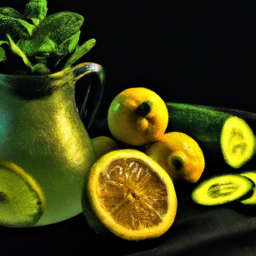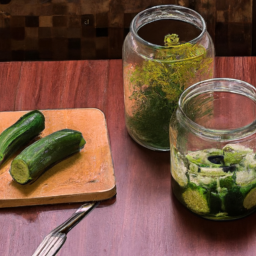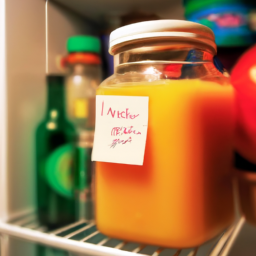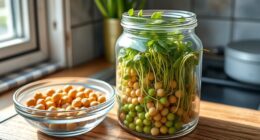I enjoy creating homemade juices, particularly in the warm summer season. A top pick of mine is the lemon cucumber juice, which is both scrumptious and full of nutritional benefits.
In this article, I’ll share with you my step-by-step guide on how to make lemon cucumber juice that is both easy and healthy.
To make this juice, you’ll need just a few ingredients that are easily accessible at your local grocery store or farmers market. Once you have everything you need, it only takes a few minutes to prepare the juice.
Whether you prefer to use a juicer or a blender, I’ll walk you through both methods so you can choose the one that works best for you.
So, let’s get started and make some refreshing lemon cucumber juice!
Key Takeaways
- Lemon cucumber juice is a great source of vitamin C and potassium, and can boost the immune system, hydrate the body, and improve digestion.
- Honey is a natural sweetener with numerous health benefits, while stevia has antioxidant properties and may have anti-inflammatory effects.
- Lemon cucumber juice can be stored in the refrigerator for up to three days or frozen in ice cube trays for up to six months.
- Experiment with flavor variations using different ingredients, sweeteners, and garnishes to enhance visual appeal and flavor.
Gather Your Ingredients
Now it’s time to grab all the necessary ingredients – including those refreshing lemon cucumbers – and get ready to make a delicious and healthy juice!
To make a classic lemon cucumber juice, you’ll need 2-3 lemon cucumbers, 1-2 lemons, 1 tablespoon of honey, and a cup of water. However, if you want to experiment with different flavors, you can opt for alternative ingredients such as ginger, mint leaves, or even kale.
There are also various variations of lemon cucumber juice that you can try. For instance, you can add some spinach leaves and a few slices of cucumber to create a green smoothie version. Alternatively, you can blend the lemon cucumbers with some pineapple chunks and coconut water for a tropical twist. The possibilities are endless, so feel free to get creative with your ingredients and come up with your unique recipe.
Now, let’s move on to the next step and wash and prep your ingredients.
Wash and Prep Your Ingredients
Before getting started, it’s important to give your chosen produce a good scrub down to ensure they’re ready for the next step. For this recipe, you’ll need one lemon and one cucumber. It’s best to use organic produce as they’re free from harmful chemicals and contain more nutrients.
When washing your produce, it’s important to use filtered water. Tap water may contain impurities that can affect the taste and quality of your juice. Filtered water removes these impurities and ensures that your produce is clean and ready to use.
After washing your produce, pat them dry with a clean towel. Now that your produce is washed and prepped, it’s time to choose your method of juicing. Note that it’s important to ensure that your juicer is clean before use to prevent contamination.
Choose Your Method
To get the most out of your ingredients and experience the flavor explosion, you’ll want to consider the method of juicing that works best for you. There are two main options to choose from: manual and electric.
Manual juicers are more affordable and require physical effort to extract the juice. They come in different shapes and sizes, but most require you to cut the lemon cucumbers into small pieces and then squeeze them by hand or using a lever. The advantage of manual juicers is that they preserve more nutrients and enzymes since there is no heat generated during the process. However, they may not be suitable for large quantities of juice or for those with limited hand strength.
On the other hand, electric juicers are faster and more convenient. They can handle large amounts of produce and require less effort from the user. Electric juicers come in different types, such as centrifugal and masticating. Centrifugal juicers use a high-speed blade to pulverize the fruits and vegetables, while masticating juicers use a slower process to crush and squeeze the juice out. The advantage of electric juicers is that they save time and energy, but they may generate more heat which can degrade some of the nutrients and enzymes.
It’s important to weigh the pros and cons of each method before deciding which one to use for your lemon cucumber juice. When it comes to juicing method, there are several factors to consider such as the amount of produce you have, your budget, and your personal preference. By choosing the right method, you can make the most of your ingredients and enjoy a refreshing and nutritious glass of lemon cucumber juice.
Juicing Method
Alright, let’s talk about the juicing method for making lemon cucumber juice.
First things first, using a juicer can make the process a lot easier and quicker. Simply cut your ingredients into smaller pieces and feed them through the juicer. However, keep in mind that some juicers may not be able to handle tougher produce like cucumber, so make sure to choose the right one.
After juicing, it’s important to strain the juice to remove any pulp or seeds for a smoother texture.
How to Use a Juicer
First, grab your juicer and get ready to extract the refreshing juice from your lemon cucumbers. Before juicing, make sure your juicer is well-maintained. Always clean it thoroughly after each use to prevent bacteria growth and avoid any unpleasant flavors in your juice. Check the blades, filters, and other parts to ensure they are working properly. If you encounter any issues, consider reaching out to the manufacturer or looking for alternative juicing methods.
When using your juicer, follow the manufacturer’s instructions carefully. Generally, cut your lemon cucumbers into smaller pieces that will fit into the juicer’s feeding tube. Turn on your juicer and feed the cucumber pieces into the machine. The juicer will separate the juice from the pulp, and the juice will flow out through a spout.
Once you have extracted all the juice from your lemon cucumbers, it’s time to move on to the next step: straining the juice.
Straining the Juice
Once you’ve extracted all the refreshing juice from your lemon cucumbers using your juicer, it’s time to strain it to remove any pulp or seeds.
To strain the juice, you’ll need a fine mesh strainer or cheesecloth. First, place the strainer over a bowl or pitcher. Then, slowly pour the juice through the strainer, using a spoon or spatula to press the pulp against the strainer to extract as much juice as possible.
If you’re using cheesecloth, simply place it over a bowl or pitcher and pour the juice through it. Then, gather the corners of the cheesecloth and squeeze it tightly to extract the juice.
Remember to discard the pulp and seeds after straining the juice. These tips will ensure that you get a smooth and refreshing lemon cucumber juice.
Now, let’s move on to the next step of the process, which is the blending method.
Blending Method
Who knew making a refreshing lemon cucumber juice could be so simple? Just toss the ingredients in the blender and voila, a delicious drink in minutes! When it comes to using a blender, there are a few blending tips to keep in mind. Make sure to start on a low speed and gradually increase to avoid any splattering. Also, blend in small batches to ensure a smooth consistency and prevent any chunks from forming.
To switch things up, try experimenting with flavor variations. Add a handful of mint leaves or a splash of lime juice for a zesty twist. Or, for a sweeter flavor, blend in a ripe pear or honey. The possibilities are endless! Now, onto the next step of adding sweetener (optional).
Adding Sweetener (optional)
So, now that we’ve covered how to make lemon cucumber juice using the blending method, let’s talk about adding sweetener. Personally, I like my juice a little sweeter, but this is completely optional.
There are plenty of natural sweeteners to choose from, like honey, agave, and stevia. Each of these options has its own unique flavor profile, so it’s important to experiment and find the one that works best for you.
Just remember to add in small amounts at a time, tasting as you go, to avoid making your juice too sweet.
Honey
To add some natural sweetness to your lemon cucumber juice, you can mix in a spoonful of honey. Honey is a great alternative to processed sugars as it’s a natural sweetener packed with health benefits.
Here are some benefits of using honey in your juicing:
- Honey’s high in antioxidants, which helps protect your body from cell damage and diseases.
- It has antibacterial and antifungal properties, which can help fight off infections and boost your immune system.
- Honey’s a natural energy booster, making it a great addition to your morning juice.
- It’s also a natural cough suppressant, making it a great addition to your juice when you’re feeling under the weather.
Using honey as a natural sweetener in your lemon cucumber juice not only adds a delicious flavor but also provides numerous health benefits. However, if you prefer a vegan option, you can substitute honey with agave.
Agave
Agave nectar is a popular alternative sweetener in many recipes. It’s made from the sap of the agave plant, which is native to Mexico. Agave nectar is sweeter than sugar and has a lower glycemic index, which means it doesn’t cause a spike in blood sugar levels. This makes it a popular choice for people with diabetes or those looking to reduce their sugar intake.
However, there are some drawbacks to using agave as a sweetener. It’s still high in fructose, which can be harmful in large amounts. Additionally, some agave nectars on the market are highly processed and may contain additives. When using agave as a sweetener, it’s important to choose a high-quality, minimally processed product.
Agave alternatives such as stevia can also be a good option for those looking for a natural, low-calorie sweetener.
In the next section, we’ll discuss the benefits and drawbacks of using stevia as a sweetener.
Stevia
Stevia is a great option for those who want a natural, low-calorie sweetener that doesn’t cause a spike in blood sugar levels. Here are some benefits of using stevia as a sweetener:
- Stevia is 200-300 times sweeter than sugar, so a little goes a long way.
- Unlike sugar, stevia has no calories or carbohydrates, making it a great option for those who want to lose weight or manage diabetes.
- Stevia has been shown to have antioxidant properties and may have anti-inflammatory effects.
- Stevia is a natural sweetener, unlike artificial sweeteners which can have negative health effects.
If you’re not a fan of stevia, there are other natural sweetener alternatives such as honey, maple syrup, or agave. However, keep in mind that they do contain calories and carbohydrates.
Now, let’s move on to adjusting the flavor of our lemon cucumber juice.
Adjusting the Flavor
If it’s too tart, can’t we just add a bit of honey or sugar for sweetness? Adjusting acidity and experimenting with flavors is a crucial part of making lemon cucumber juice.
While lemon and cucumber are inherently refreshing, the juice can still come off as too tart for some people. Adding sweeteners like honey or sugar can help balance out the flavors and make the juice more palatable. When adjusting the flavor of your lemon cucumber juice, start by adding small amounts of sweetener at a time.
Taste as you go to avoid making the juice too sweet. Keep in mind that adding too much sweetener can also mask the natural flavors of the lemon and cucumber. Experiment with different types of sweeteners, such as agave or stevia, to find the one that best complements your taste buds.
To enhance the flavor even further, consider adding other ingredients like mint or ginger to the mix. The possibilities are endless when it comes to creating your ideal lemon cucumber juice. Once you have perfected the flavor, it’s time to move on to serving suggestions.
Serving Suggestions
Get creative with your serving suggestions for lemon cucumber juice to make it more visually appealing and add an extra touch of flavor. Consider adding creative garnishes such as sliced cucumber or lemon wedges to the rim of your glass or adding a few drops of honey or agave syrup for a touch of sweetness.
You can also pair your juice with light, refreshing foods like salads, grilled chicken or fish, and fresh fruit for a complete meal. Another fun way to serve your lemon cucumber juice is to add a splash of sparkling water for a fizzy twist. This adds a refreshing effervescence to your drink and makes it perfect for sipping outdoors on a hot summer day.
You can also experiment with different herbs like basil, mint, or thyme to add a subtle hint of earthy flavor to your beverage. These simple additions can make all the difference in elevating your lemon cucumber juice from a simple drink to a delightful and elegant beverage.
Adding creative garnishes and pairing options to your lemon cucumber juice not only enhances the flavor and visual appeal of your drink, but it also provides a well-rounded meal when paired with complementary foods.
In the next section, we’ll explore the numerous health benefits of lemon cucumber juice.
Health Benefits
Boost your immune system, hydrate your body, and improve digestion with this refreshing lemon cucumber juice that’s packed with vitamins and minerals.
Lemon and cucumber are both great sources of vitamin C, which is essential for a healthy immune system. Vitamin C also helps to reduce inflammation in the body, which can contribute to a variety of health problems. Additionally, cucumbers are high in potassium, which helps to regulate blood pressure and improve cardiovascular health.
To make this healthy and delicious juice, simply blend together fresh lemon juice, cucumber, and a bit of honey or stevia for sweetness. You can also experiment with adding other ingredients like ginger or mint for added flavor and health benefits.
Drinking this juice regularly can help to improve your overall health and well-being, so give it a try and see how it makes you feel!
Now that you know the benefits of this tasty drink, let’s move on to the next step: storing your juice.
Storing Your Juice
When it comes to storing your freshly made juice, there are a few things to keep in mind to ensure it stays as fresh as possible. First, refrigeration is key. Be sure to store your juice in an airtight container in the refrigerator to prevent spoilage.
If you want to keep your juice for longer than a few days, freezing is also an option, but be aware that the taste and texture may be altered. It’s important to follow best practices for longer storage, such as using quality produce and properly cleaning and preparing your equipment before juicing.
Refrigeration
For optimal freshness and taste, make sure to refrigerate your lemon cucumber juice before serving. When storing your juice in the refrigerator, there are a few tips to keep in mind.
First, make sure to use an airtight container to prevent any air from getting in and causing spoilage. Glass jars or bottles with tight-fitting lids are great options.
It’s also important to store your juice at the proper temperature. The ideal temperature for lemon cucumber juice is between 32 and 41 degrees Fahrenheit. If your refrigerator has a special compartment for storing drinks, that’s the perfect place for your juice. Avoid storing it on the door, as the temperature is not as consistent there.
With these tips, your lemon cucumber juice should stay fresh for up to three days in the refrigerator. Now, let’s talk about how to freeze your juice for longer storage.
Freezing
To extend the shelf life of your refreshing lemon cucumber juice, try freezing it in ice cube trays. This method allows you to keep your juice for up to 6 months without compromising its quality and taste. Here are some benefits of freezing your juice:
- Freezing your juice helps retain the vital nutrients present in the fruit and vegetables, unlike other preservation methods that may cause a loss of nutrients.
- Freezing your juice in ice cube trays allows you to have convenient portions that can be used for various purposes, such as adding to smoothies or as a base for cocktails.
- Frozen lemon cucumber juice can be used as a base for alternative recipes, such as popsicles or sorbets, that are perfect for hot summer days.
In addition to freezing, there are some best practices for longer storage that you can follow to ensure your juice stays fresh.
Best Practices for Longer Storage
Now that we know how to freeze lemon cucumbers properly, let’s talk about the best practices for longer storage. As someone who loves to have fresh fruits and vegetables on hand, I have learned a few tips for preservation and preventing spoilage.
Firstly, it’s important to store your lemon cucumbers in a cool, dry place. This will help prevent moisture from building up and causing the cucumbers to rot. Additionally, you can wrap them in a paper towel or cloth to absorb any excess moisture. Secondly, try to use your lemon cucumbers within a week of purchasing or harvesting them. This will ensure that they are at their freshest and have the most nutritional value.
To help you keep track of your lemon cucumber storage, here is a helpful table outlining some best practices:
| Storage Method | Temperature | Duration |
|---|---|---|
| Room Temperature | 50-70°F | 1-2 Days |
| Refrigerator | 32-40°F | Up to 1 Week |
| Freezer | 0°F | Up to 6 Months |
By following these tips and keeping track of your storage methods, you can enjoy your lemon cucumbers for longer periods of time and prevent any unnecessary waste. So go ahead and stock up on these tasty and nutritious cucumbers, knowing that you have the tools to keep them fresh for longer.
Frequently Asked Questions
How many lemons and cucumbers do I need to make a batch of juice?
Ah, the age-old question of how much produce is needed for lemon cucumber juice. Well, my dear, it all depends on your taste buds. Experiment with adjusting sweetness and blending time until you find your perfect ratio.
Can I substitute honey or agave for sugar as a sweetener?
I prefer using honey instead of sugar in my lemon cucumber juice as it adds a natural sweetness and is a healthier alternative. Studies suggest that lemon cucumber juice with honey has antioxidant and anti-inflammatory properties that can boost your immunity.
How long should I blend or juice the ingredients for optimal flavor?
To achieve optimal flavor in my lemon cucumber juice, I blend the ingredients for about 2 minutes, ensuring a smooth consistency. Taste balance is important, so I adjust the amount of lemon and cucumber to my liking.
Can I add other fruits or vegetables to the juice for added nutrition?
Yes, adding fruits and vegetables to your juice combinations can provide additional nutritional benefits. Try adding leafy greens like spinach or kale, and fruits like berries or apples for added flavor and nutrients.
How long can I store the juice in the refrigerator before it goes bad?
Storing juice is like preserving a memory. The shelf life of lemon cucumber juice is typically 2-3 days when refrigerated in an airtight container. Discard if it smells or tastes off.
Conclusion
So there you have it, a step-by-step guide on how to make lemon cucumber juice. Whether you choose to use a juicer or blender, the end result is a refreshing and healthy drink that you can enjoy any time of the day.
Just like how we must take care in selecting and prepping our ingredients, we must also take care of our bodies and health. Lemon cucumber juice is not only delicious, but it also provides a multitude of health benefits such as aiding in digestion, boosting your immune system, and improving skin health.
So, the next time you reach for a sugary drink, think about the many benefits of lemon cucumber juice and give it a try. As the saying goes, "you’re what you eat,"so why not nourish yourself with the best ingredients possible?
Ilana has been a vegan for over 10 years. She originally made the switch for health reasons, but soon found herself becoming more and more passionate about the ethical and environmental implications of a vegan lifestyle. Ilana is the author of The Graceful Kitchen, a blog all about veganism. She loves to cook up delicious and nutritious vegan meals, and share her recipes with others who are interested in leading a cruelty-free life. Ilana is also a strong advocate for using whole foods as the foundation of a healthy diet, and believes that going vegan is one of the best ways to achieve this.










